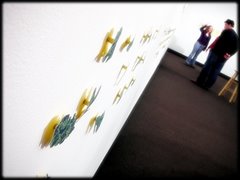Perception-Guided Image Editing
Reynold Bailey, Washington University in St. Louis
Practically, the lecture was focusing on the human eye
more than image editing that what I expected to learn from it.
Still it is true that the knowledge about human eye system and its functions is helpful
to do art, especially to edit images.
Reynold talked about our two visual sub-systems:
Peripheral vision subsystem and Foveal vision system.
The first system has low visual acuity but fast and sensitive, and the later system has high vsivual acuity but slower. It was interesting for me because before I heard his lecture I did not know visual acuity actually affect how fast our human eyes accept the visual signals.
Since most of art works deal with visions - things that we can see through our eyes - it is important to acknowledge the different results you can make from varying your visual acuity.
One physical fact that surprised me was that things we believe we see every moments
when we open our eyes to receive visual signals
are just occupied only 2 percent of the vision field.
The rest 98 percent of the vision field that we see is just a production of your memory from your brain. It was important for implying in the field of image manucripition.
For example, in non perspective cues, like color and luminance, you can control the audience.
It is inaccurate to say you can "control" the audience, but it is true that you can change what they feel about it.

No comments:
Post a Comment